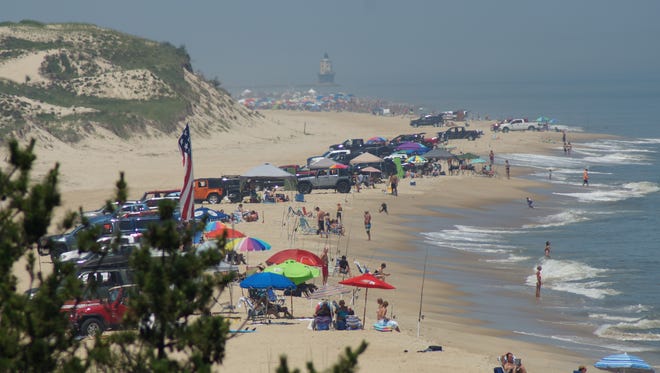Drive-on beach crowds always find a way
For Danny Cordrey, traveling from Middletown to Cape Henlopen State Park to drive a truck on the beach for a day of surfing, sitting and beer-sipping is a four-decade-old custom.
He's got the gear down to a science. Pop-up tent for use as a bathroom: check. Multiple coolers: check. Pro forma fishing pole to ensure park police note that he's "actively fishing," which state law requires drive-on beachgoers do: check.
"I have to throw a line in, even though I know there's not any fish to catch right now," Cordrey said, shrugging, on a hot Friday afternoon at the park's Herring Point beach. For most of a mile south of him along the shore line, pickups and SUVs were backed up to the surf's edge.

Two years into a new rule forbidding drivers to stack their trucks several deep on the drive-on beaches like they used to on holidays and busy weekends, the pastime is as popular as ever, park officials and fishermen say. While fewer vehicles can be on Sussex's drive-on beaches at any one time, beachgoers have adapted by hitting the sand earlier and staying later.
"I can't say that we're seeing a huge difference in numbers, but we're definitely seeing compliance," said Wayne Kline, chief of enforcement for the state park system. "What we are seeing, at Cape Henlopen especially, is people coming earlier than in previous years. On a great Saturday morning, we get a lot of people out there at 9:30 or 10 in the morning. Some people may fear they may not get on" unless they show up by then.
In 2014, park rangers counted 987 vehicles on Cape's four drive-on beaches one especially busy day, a number they thought close to unmanageable. So last year, the parks had a new rule: Trucks had to park single-file.
That's diminished crowding on the beaches on peak days, but only by degree. Kline said last year's busiest day had about 890 vehicles on Cape's beaches. So far this year, he said, July 2 was the high point, with 830 trucks.
"I think this can be considered the new normal," Kline said. "Numbers are down a little as far as visitation, but we haven't had the best weather."

To drive on the beaches, you need to obtain surf fishing tags for your pickup or SUV, and make sure you have four-wheel drive or all-wheel drive. It's also required that you carry a shovel, plank, jack and tow rope to get unstuck from the sand, and if rangers believe your group is not "actively fishing," you'll be warned or cited.
The Delaware Mobile Surf-Fishermen club, which lobbies lawmakers on access issues, supported the single-file rule. Frank Payton, a regular surf fisherman from Milton, says popular weekends still aren't the best times for dedicated fishermen to drive on, but he understands the park's challenges in regulating the beaches.
With cars spread out more evenly along the shoreline, empty areas are harder to find, and "there's even less places to actually fish," Payton said. "If anything, it made fishing harder, but we understand why it happened." His solution: "Fish inland. Wait out the summer. Fish the crappy days."

Cordrey, meanwhile, says he and his friends will keep coming several times a summer to enjoy the beach relaxation they pine for. And driving on instead of walking, he says, means all kinds of creature comforts are available.
"I didn't bring it today, but I do have a gasoline-powered blender. It'd be nice to have it here. Has a weed-whacker engine in it," Cordrey said. "It's called the Tailgater. Good for making daquiris."
Contact James Fisher at (302) 983-6772, on Twitter@JamesFisherTNJorjfisher@delawareonline.com.